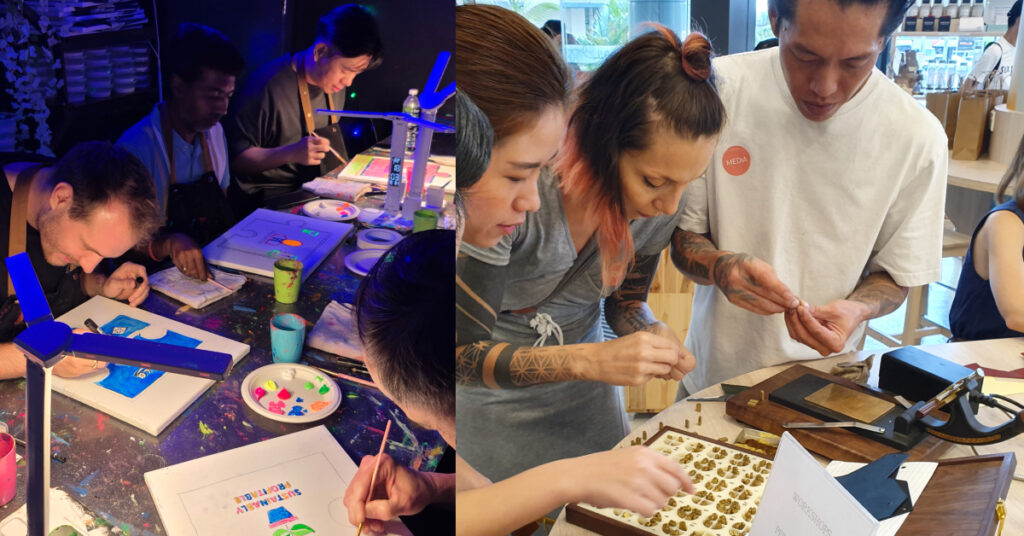
Having to change your original business plan is hard, but here’s how they pulled it off
Amidst a colourful scene of arts and crafts workshops in Singapore, novelty is the key driver for survival and growth. But just like trends, what’s new would be considered old in a matter of months, weeks and even days, and business owners need to learn when to make the switch.
For 20-year-old Merida Lim and 34-year-old Raymond Tan, founders of neon art studio SCURO and leather crafter Crafune respectively, they found themselves struggling to survive when they first launched their businesses, and they were running out of funds at a worrying rate.
This pushed them to make risky pivots to their businesses, and fortunately, they’re paying off.
Don’t be afraid to change your entire sales pitch

When Merida Lim first opened her art jamming studio SCURO in last Oct, she became known as the 19-year-old behind Singapore’s first horror art jamming studio. The business found a strong following of horror art fans in Singapore, and the concept went viral on social media.
However, despite the traction it received, the studio was barely breaking even, and Merida quickly realised it could not sustain itself in the long term.
“Every time I would talk to people at the horror art jams, they’d be like ‘okay, we’ll come once every three months at best.’ I just had a gut feeling that there will be a lot of bookings during Halloween, but it will decrease slowly after.”
Merida began exploring a variety of art jamming concepts, including fantasy themes and candlelight-themed workshops. She eventually discovered neon art and took a gamble on it after receiving several enquiries from parents. “A lot of parents responded, and they were like ‘Oh, I want my kid to try it.’”
Encouraged by the demand, Merida decided to undergo a complete overhaul, replacing their horror art jams entirely with neon. SCURO went viral once again on social media when she hosted a class for Starley Tan and her parents, content creators Jianhao and Debbie Tan, helping the business gain steady ground.
Homegrown leather crafting studio Crafune also underwent a similar trajectory. After picking up the craft as a hobby since his days as a member of the Singapore Army’s explosive ordnance disposal team, Raymond Tan decided to start his own studio in 2018 at Haji Lane, with the aim of selling his handmade leather products.
In addition to selling his crafts, he also decided to start conducting leather crafting workshops, as there were no other such classes at that time. After some time, he noticed that his workshops were gaining more traction and financial gains compared to his retail sales. This led him to rewrite their business plan and stop selling his leather products, focusing only on workshops instead.
Catering to your audience & being open to new opportunities

However, getting the business off the ground required heavy capital investments and sacrifice. Having invested six figures to launch the business, Raymond was left with little capital to run the business and had to rely on his savings. As such, he was unable to purchase his leathers in bulk, which inevitably raised the costs of his raw materials.
In addition, the business was at the mercy of four-digit monthly rentals at their first studio at Haji Lane, and he couldn’t draw a salary for about a year. “It caused our margin to be really, really low. Honestly, at one point, our margin per workshop was about S$10,” he lamented. “We survived based on our own pocket money, our own savings.”
As such, Raymond made it a point to establish Crafune as a business that not only offered one-of-a-kind experiences but also opportunities to offer deeper lessons on the art of leather crafting, from the origins of the different types of leather to the techniques used.
“We want to make learning interesting and fun. We don’t want them to just come for workshop and go. It’s not just about experiencing the process. It’s about going through it to understand the process and be able to apply the same thing in the future,” he explained.
The team at Crafune continued to experiment with different workshop formats over time, adding and removing options based on whether the participants were able to learn something new or if the item they were making was functional enough.
“There are times where we think that ‘yes, it will be able to educate the customer,’ but after running a class for a few times we realise that ‘no, this is not the best way to teach,’ we remove the workshop from our listing,” explained Raymond. “End of day, we have to think about how we can serve the customer.”
Since Crafune’s inception in 2018, Raymond has seen many workshops come and go. At one point, four businesses were offering the same experience at Haji Lane, and some of the owners approached him for advice.

“I actually told them that if the four of you are doing the same thing and you guys think that your [experience] is a novelty, then it’s no longer a novelty after a few months because everyone will get sick of it,” he candidly shared. “They all gave up the business within a year.”
Merida echoed a similar perspective, taking a chance at a different audience: families with young children. She noted that businesses that focus on adults are more challenging as they are more conscious of their own spending, and that novelty wears down fast with each passing trend.
“I see this business that is more kid-focused, and I know that there are always going to be kids born every year. So it’s more of a question on how do we keep it relevant for the kids now,” she shared.
Though SCURO was able to capitalise on its online virality on multiple occasions, Merida knew better than to heavily rely on it for growth. She emphasised that innovation is necessary for small arts businesses like hers to survive, and even though its original concept may shift, doing so allows the business to keep running along with the times ahead.
Continue finding a niche space for yourself
That said, both businesses have diversified their revenue streams, becoming brands that are known for more than just providing workshops to the masses. For Crafune, the business took a heavy blow during the COVID-19 pandemic, as the nature of the virus prohibited them from hosting in-person classes.
This pushed Raymond and his team to offer virtual workshops and sell toolkits and leather hides for hobbyists looking to experiment on their own. The studio also decided to launch its ready-made leather goods for sale in 2021 to supplement its income.
Though they temporarily stopped sales, they have since re-launched them again in 2023 after multiple participants started enquiring about whether Crafune will sell their products for retail. The studio has also started offering corporate gift packages and wedding favours.
While workshops remain to be the businesses’s bread and butter, diversifying their income streams has helped Crafune to successfully expand to two locations: New Bahru in 2024 and Funan this Oct.

For SCURO, however, their original workshops have become the studio’s secondary source of income, as they have since established themselves as party hosts, specialising in neon birthday parties for children.
Merida explained that when she rebranded the studio, the business was only making a little bit of profit. But upon meeting her investor and eventual co-founder, Andy Teoh, he advised that SCURO should focus on its birthday parties rather than its workshops, given the higher profit margins they generate.
“I saw a problem where it’s always the same things in Singapore and there’s no new things for the parents to do. I guess that’s also a reason why when someone suggests having neon parties, suddenly all the parents want to jump on that trend because they are constantly looking for new ideas for their kids,” she added.
Through their activations and one-of-a-kind concept, Merida shared that the studio continued to receive full bookings, and monthly revenue has increased fivefold. This has paved the way for the company to open its second outlet at Serangoon.
That said, SCURO has not discontinued its workshops and team bonding sessions for corporate groups, such as Marina Bay Sands and social service agency AWWA, in a bid to cater to multiple age groups, allowing the business to retain versatility in the long term.
“You can curate these experiences under your umbrella such that once one experience kind of dies out, then you’ve got another one to hop on, and then this trend might come back again five years later.”
- Read more stories we’ve written on Singaporean businesses here.
Also Read: Five tufting studios closed. WeTuft bought their yarn and kept going.
Featured Image Credit: SCURO/ Crafune
Last modified: November 23, 2025







